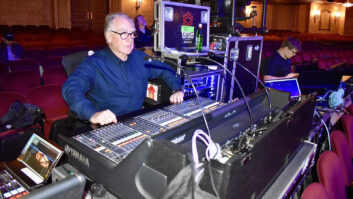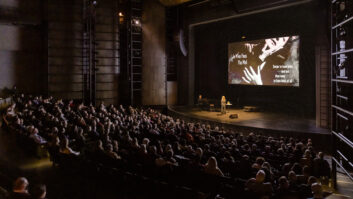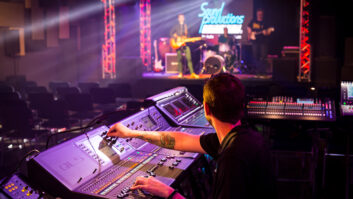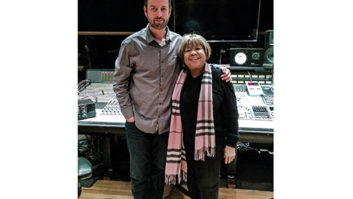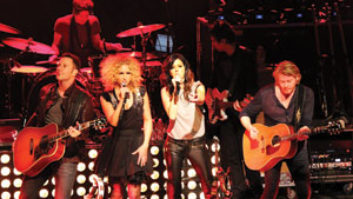When Chris McHale and his partner Joe Barone drew up plans for their new facility, Irving’s Place, they kept the ad market firmly in mind. “We had been working in studios for years, first as creatives at DDB Needham, and later as principals of McHale/Barone, our own creative services shop,” McHale says. “We know the pressures that exist in the advertising world, and how big a part a comfortable environment plays in making a session go smoothly.”
McHale, a music producer and copywriter, and Barone, a copywriter and in-house voice talent, had worked in countless video and editing facilities across the country, as well as numerous audio studios. By and large, they found, audio rooms lacked comfort. “Margarita Mix in L.A., however, is set up more like a house than a facility,” McHale says. “The equipment is great and the staff is first-class, and that combination is what we’re going for here at Irving’s Place.”
The New York advertising community, feeling the squeeze of high rents in Midtown, continues its southerly migration, as facilities servicing the agencies are increasingly populating lower parts of Manhattan. Irving’s Place, located on, that’s right, Irving Place, just off 14th Street and Park Avenue, is set up in a prime location. “We’re really pleased to be down here; it’s an exciting, growing area for our business,” McHale says. Although the owners consulted with several studio design professionals, McHale says that the bulk of the plans were drawn up by the two principals and their architect, Peter Wormser. “Peter’s an interesting dude; he has a real SoHo vibe,” McHale says. “He designed Crew Cuts, and that studio felt very different for me when I worked there-it was just the style I was looking for.
“We talked with him about the idea of having lots of windows and light. We’ve got a lot of space [10,000 square feet], and we wanted to have the studios sitting in a circle in the center of the space, with an outer ring that people can walk around,” he continues. “This place, which turned out just as we planned, is bright and airy. The acoustically treated spaces are on the inside, including the live, floating room, which sits at the very center of our facility.
“No traditional studio designer would advise having windows in the rooms themselves, but the sonic purity was something we were willing to trade for comfort. The rooms are connected visually; it’s kind of like a honeycomb. You’re not working in an isolated environment, but an open one that has lots of creative cross-currents. Plus, we think the rooms sound great!”
Most of the monitoring that takes place in audio post, it seems, turns on near-field work at low decibel levels. “We’re not looking to create hit records here,” McHale says. “and so a lot of the dynamics issues that studio designers were talking to us about were unnecessary. We simply don’t listen to work at 110 dB-most of our listening takes place at about the 50dB level. We’re using an Atlantic Technologies 371 monitoring system, which is set up for 5.1 mixes. As of yet, we’ve not gotten much call for surround sound mixes, but that day will come.”
Irving’s Place was designed so that all of the three main rooms have Pro Tools MIX Plus systems (with Yamaha 02R consoles and Pro Control front ends) that feed into the studio’s machine room, where all of the facility’s Mac G3 computers reside with Digital Betacam and D2 video playback machines and hard drives used to digitize picture. Cutting out clutter in the work spaces was an important part of the design, as was having the hub act as a router for any of the studio’s total of 64 Pro Tools tracks. “Again, the idea is to create as pleasing a space as possible,” McHale says. “Tripping over computers and racks of gear is counterproductive. When you work in our rooms, all you have is a keyboard and monitor-everything else functions out of your line of vision. We may have one room where voice-over is being recorded over a stereo pair of stock music tracks. In that case, we’ll assign a modest amount of Pro Tools tracks to that room, leaving the rest available for the more track-intensive sessions that may be taking place in other rooms.” In addition to the three main mix rooms, Irving’s Place has three MIDI rooms, each set up with Logic Audio and Pro Tools.
Staff members, always available to Irving’s Place clients, include Doug Di Franco, a highly successful audio post engineer who has put in stints at East Side, Superdupe and National Sound. Casey Cheater writes, produces, engineers and plays on a variety of projects (his dad, Gary, is an engineer who has worked with Phil Ramone, as well as Sinead O’Connor and a host of other major recording artists, and his grandfather played on Van Morrison’s “Brown-Eyed Girl” and Jim Croce’s “Bad, Bad Leroy Brown”). Recording engineer/mixer Tim Leitner, who has been with McHale/Barone since 1996, has a catalog that includes work for Paul Simon, Bruce Springsteen and Stevie Nicks. All of this talent, plus the skills of the two principals, is available throughout the day-and often into the nights.
“Collaboration is what it’s all about,” McHale says. “Stock music, original scores, sound design-if you’re a producer at an advertising agency, you’re never quite sure what you’re going to need at a particular moment. We find that a client may come in to record a voice-over one time, and the next time they’ll be asking for a second, and then a third service that we offer. The Discovery Channel recently asked us to write some copy for them. They came in as a mixing client of Doug Di Franco’s, had us compose a piece of music for a film they were doing, then got in trouble with their agency and asked us to write that piece of copy. That’s how things work.”
